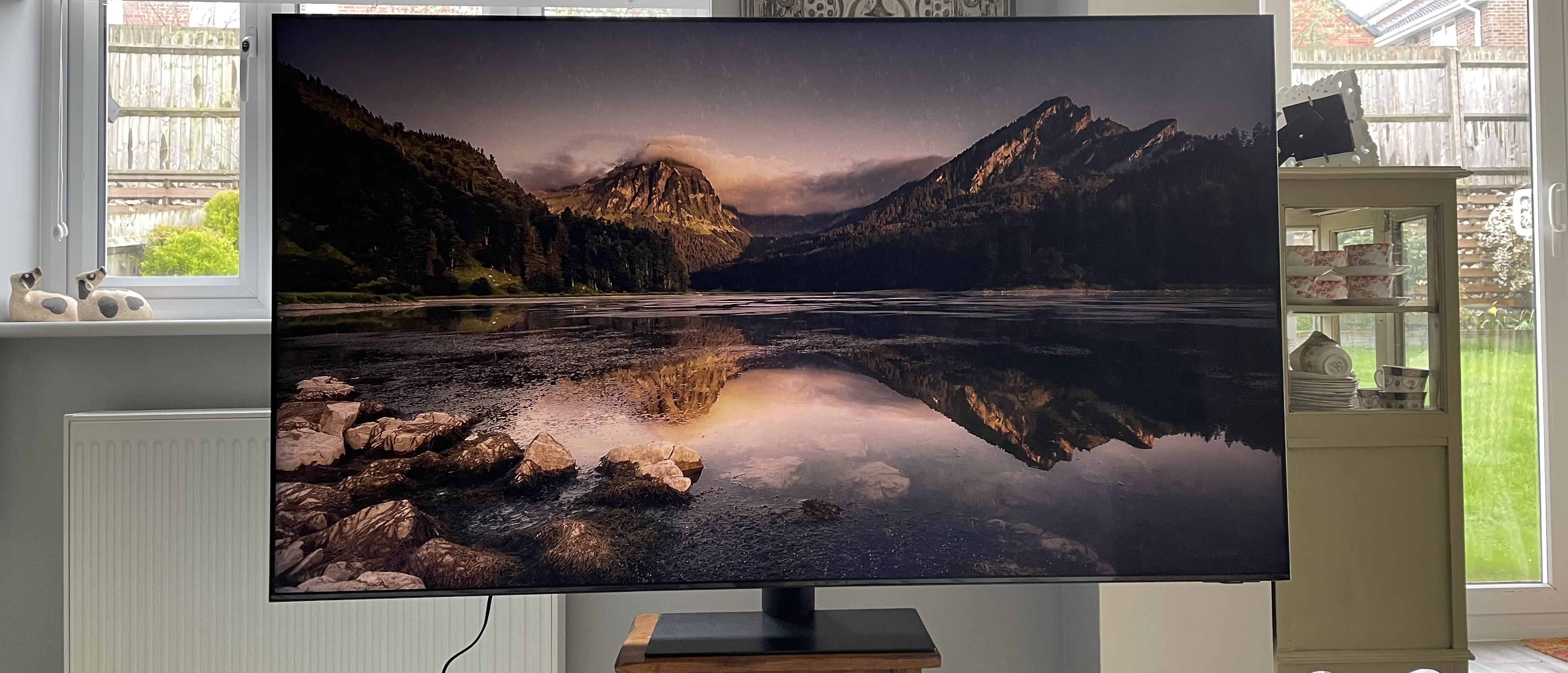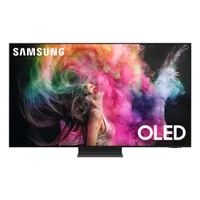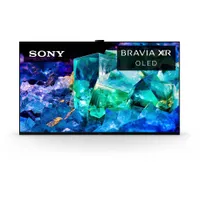TechRadar Verdict
With almost twice as many local dimming zones to work with as its predecessor, the Samsung QN95C takes LCD’s handling of dark scenes to a new level. And it does so without compromising the dazzling brightness and color the best LCD TVs are renowned for. Getting the best from it can take a little work, but the ends spectacularly justify the means.
Pros
- +
Picture offers a dazzling mix of brightness and blackness
- +
Gaming features are outstanding
- +
Refined picture processing
Cons
- -
Expensive compared to competition
- -
No Dolby Vision support
- -
Some backlight issues need to be worked around
Why you can trust TechRadar
Samsung QN95C: Two-minute review
Samsung’s 2022 mini-LED models certainly improved on their predecessors, thanks to better processing and a new shape adaptive light control feature that refined how light was used within each dimming zone. But in retrospect, the lack of any actual extra new dimming zones definitely limited their progress. How do we know this? Because the brand’s flagship 4K TV for 2023 – the Samsung QN95C – nearly doubles the number of dimming zones over last year’s Samsung QN95B, and the results are nothing short of spectacular.
Black levels are sublime by LCD TV standards, hitting depths so pure and inky that they’re pretty much indistinguishable from the sort of stuff we once thought we’d only see from self-emissive technologies such as what's found in the best OLED TVs. Even better, thanks to the massive dimming zone count, the rich blackness of the QN95C’s dark scenes is remarkably consistent and cloud-free across the screen, even when a mostly dark scene has some tricky bright bits to handle.
The Samsung QN95C’s push for better black colors doesn’t mean it can’t still deliver the same level of extreme brightness that is premium LCD TVs' trademark though. This ensures that it remains a great bright room option, despite also being able to adapt better to lights-off movie nights.
Add a stellar gaming experience and much-improved sound to the mix and there’s no doubt that mini-LED still refreshes some picture parts that other technologies cannot reach.
Samsung QN95C TV review: price and release date
- Release date: March 2023
- QE55QN95C: $TBC / £2,799
- QE65QN95C: $3,299 / £3,699
- QE75QN95C: $4,199 / £4,999
- QE85QN95C: $5,799 / £6,999
The Samsung QN95C series is the company’s top-tier 4K OLED TV model. Pricing so far has been announced for the UK and the US (except for the 55-inch model), but not for Australia.
While I think we can all agree that the 65QN95C's price point of £3,699 in the UK and $3,299 in the US puts it squarely in the high-end TV category (you can, after all, get perfectly functional 65-inch TVs for well under a grand these days), the price differences in these two key territories tell two slightly conflicting stories.
In the UK, where the 65QN95C costs £100 more at its March 2023 launch than Samsung’s 2023 premium QD OLED TV – the 65S95C – it seems that Samsung is clearly making a statement that it continues to see mini-LED technology as the jewel in its TV crown. In the US, though, Samsung has chosen to launch the 65QN95C for exactly the same price as the 65S95C, essentially positioning both technologies on a performance par and letting the consumer place their $3,299.99 / £3,699 where they will.
Sign up for breaking news, reviews, opinion, top tech deals, and more.
For what it’s worth at this early stage in the review, we’re probably more inclined towards the US approach, with Samsung’s QD-OLED and mini-LED models arguably being more about satisfying different types of customer than one actually being hands down better than the other.
Samsung QN95C TV review: Specs
| Screen type: | QLED with mini-LED |
| Refresh rate: | 120Hz |
| HDR support: | HDR10+, HDR, HLG |
| Audio support: | Dolby Atmos, Object Tracking Sound Pro |
| Smart TV: | Tizen |
| HDMI ports: | 4x HDMI 2.1 |
| Built-in tuner: | ATSC 3.0 |
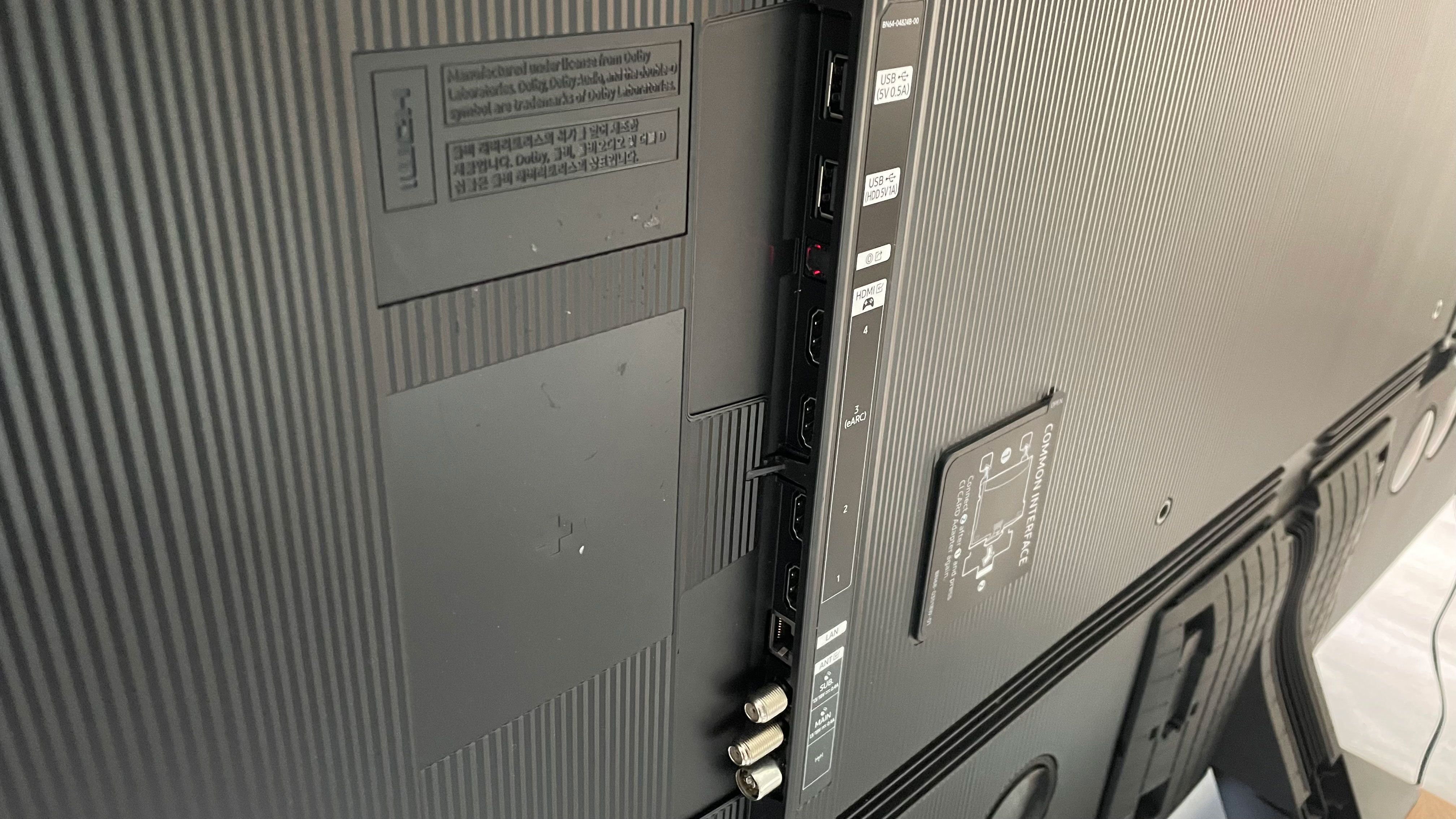
Samsung QN95C TV review: features
- Mini-LED panel with local dimming
- Native 4K resolution with HDR10+ support
- AI processing
With both QD-OLED and traditional OLED screens all seriously upping their games for 2023, Samsung clearly needed to do something drastic with its mini-LED TVs too. Which they have, in the shape of far more local dimming zones driving their tiny LED lights than we got last year. We’re talking 1344 versus 720 separately controlled areas of lighting – a much bigger increase in a single generation than we’ve seen from Samsung before.
This substantial upgrade is made all the more exciting when combined with a new, improved Neural Quantum 4K processor, the screen’s mini-LED lighting and the return of Samsung’s Shape Adaptive Light technology, which manages to adjust the wavelength of the light in any given dimming zone to try and help it blend in better with its neighbors.
Brightness peaks at beyond 2000 nits on a 10% of the screen area white HDR test pattern across the QN95C’s picture presets, and the set also manages a monster 805 nits with full-screen bright HDR images. Even the latest QD-OLED TVs will struggle to get past 1400 nits and 260 nits for 10% and 100% white HDR patterns respectively. It’s here, really, where mini-LED technology continues to earn its corn despite the onslaught of fast-improving OLED rivals.
While the QN95C hasn’t to our knowledge increased the number of mini-LEDs illuminating its pictures from last year’s QN95B, it’s worth restating why mini-LED technology matters. Namely that by using LEDs 40 times smaller than those you get in standard LED TVs, mini-LED screens increase the ability for control over where their light goes – with potential knock on effects into contrast, color and brightness. That becomes especially powerful when partnered with a local dimming system as extreme as the one in the QN95C.

Driving all these tiny LEDs and local dimming zones, along with other key features of premium 4K TVs such as noise handling, motion processing, HDR tone mapping and colour management, is a new version of Samsung’s Neural Quantum 4K processor that now draws on the pool of knowledge assembled by an impressive 20 different neural networks.
The processor’s power isn’t just restricted to picture quality, either. It also has a big part to play in the effectiveness of the TV’s object tracking sound (OTS) system, which uses the 70W, 4.2.2 channel speaker array to make specific placement so sound effects appear to be coming from exactly the right part of the screen. Experience suggests, too, that the OTS sound engine should play nicely with the QN95C’s built-in Dolby Atmos decoding.
The Dolby Atmos talents also extend to sending Dolby Atmos soundtracks (in the lossy Dolby Digital+ format) wirelessly to compatible Samsung soundbars. Samsung doesn’t bite the whole Dolby budget, though, as the company still refuses to support the Dolby Vision HDR format. Its HDR support is therefore limited to HDR10, HLG and HDR10+.
HDR10+ is like Dolby Vision to some extent – at least in the way it includes extra scene by scene picture data in its HDR feeds that compatible TVs can use to deliver more accurate HDR pictures. However, HDR10+ is used substantially less in the content creation world than Dolby Vision. With anything mastered in Dolby Vision, the QN95C will only be able to play the HDR10 core of it, without the extra scene by scene data.
One last unexpected feature of the QN95C finds it shipping with a slim detachable camera designed to sit in the middle of the TV’s rear top edge. This opens up the potential for controlling the TV via gestures as well as getting real-time feedback on your exercise form and even your vitals when you’re participating with the exercise videos Samsung now provides as part of a well-being section in its smart features. I personally suspect, though, that most people will feel fairly content just leaving the camera in the box.
- Features Score: 5/5
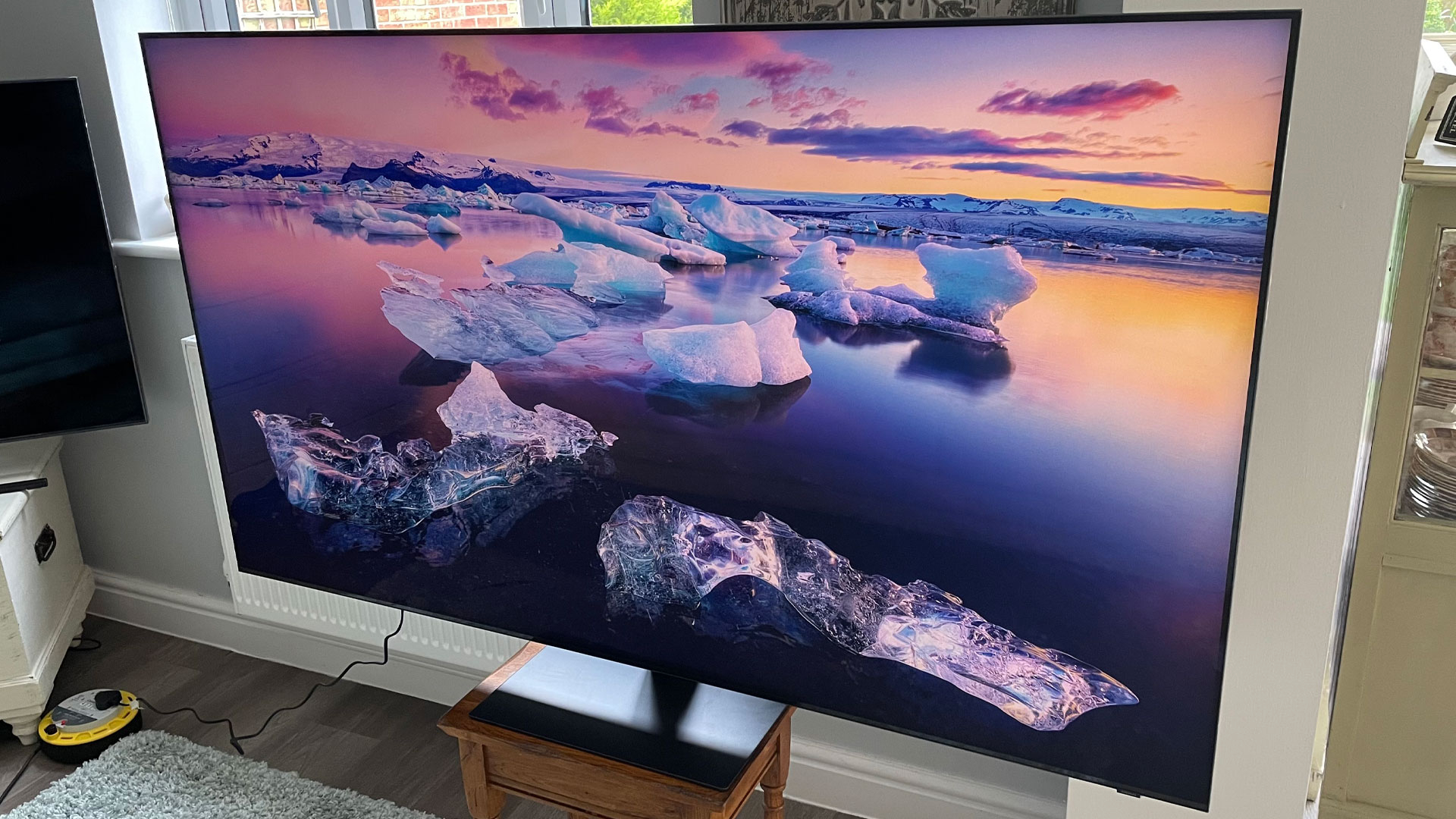
Samsung QN95C TV review: picture quality
- Excellent black levels and blooming control
- OLED-beating brightness
- Some presets and features need handling with care
There are two standout points about the Samsung QN95C’s pictures. Firstly, how much the improved dimming zone count impacts black level performance and backlight ‘blooming’ around stand-out bright objects. And secondly, how much of a brightness advantage, if any, it holds over the new generation of Quantum Dot and Micro Lens Array OLED TVs coming through this year.
Starting with the backlight performance, the news is mostly fantastic. During dark scenes and fade to blacks, for instance, the QN95C hits black level depths that it’s hard to believe are being delivered by an LCD TV. Especially as the inky, natural, greyness-free black colours aren’t partnered with the sort of distracting backlight ‘blinking’ you often see with less able LCD TVs when they’re trying to do justice to a fade to black. Making this OLED-like black level performance all the more impressive is the way the inkiness of the QN95C’s black levels remains almost completely free at all times of the sort of localised areas of clouding or blooming that so often accompany even the best locally dimmed LED TVs to some extent.
This does have a couple of negative side effects in some settings, as I’ll discuss later, but for most of the time the 65QN95C’s ability to simultaneously achieve deep, deep black levels and avoid backlight blooming makes it a wonder of the LCD TV world.
You might think that an LCD TV that handles black levels and dark scenes as well as the QN95C must have had to seriously compromise its brightness potential. Actually, though, the set still proves measurably capable in its default Standard preset of shipping a massive 2240 nits of brightness on a white HDR window covering 10% of the screen. This drops a little to around 2000 nits with the more accurate Movie and Filmmaker Mode presets, but these are still huge numbers – around 40% higher than what even the new generation of brighter OLEDs can manage.
The QN95C’s brightness advantage over OLED is even more pronounced with full-screen bright content, where its 805 nits in Standard and around 700 nits in Movie and Filmmaker Mode measurements are three to four times higher than those of the latest premium OLEDs. I would add, though, that while these measurements are impressive with test screens, it was strangely only in the TV’s Dynamic preset where I consistently felt the impact of this brightness with real world content.
Brightness is of course only one part of TV picture quality. But as we’ve already seen, the QN95C is also capable of delivering class-leading (for LED) black levels.
It’s also killer in the colour department, drawing on its brightness and colour processing to cover an extremely large volume (colour volume being the combination of brightness and saturation). It has has the processing know-how too, bolstered this year by a new desire to try to express colour and image depth in a way more aligned to the way we perceive the real world, and with exceptional subtlety and refinement.
The much-improved light consistency of the QN95C’s new local dimming system additionally helps colours enjoy notably more consistency across the image, as well as helping the screen retain better saturations during dark sequences. All this improved colour consistency in turn joins forces with the finer light control and some striking enhancements in the QN95C’s ability to detect and effectively deal with picture noise to deliver a picture that looks immensely detailed and refined. It's almost like 4K on steroids at times, yet without that forced, unnatural feeling that has sometimes accompanied Samsung’s sharpest pictures in previous years.
The improvements in the latest AI-bolstered processor can be seen in how well the QN95C upscales HD and even SD sources to its native 4K resolution, too. The upscaler’s ability to detect the difference between source noise (be it exaggerated grain or digital compression artefacts) and real picture information as it goes about adding pixels to the picture is uncanny.
One last big plus of the QN95C versus its predecessor and LCD TV technology generally is the way its pictures lose remarkably little brightness or colour, and also still manage to suppress backlight blooming, when viewed from even quite wide horizontal angles.
Much improved though the QN95C is over its predecessor and arguably any other LCD TV to date, it’s not completely flaw-free. The main issue is that in the all-round most dramatic and satisfying default Standard preset, relatively small bright objects that are presented against very dark backdrops can dim down quite significantly as Samsung pursues its obsession with making sure you never see strong areas of backlight blooming.
This happens less often than it has on previous Samsung mini-LED generations, but it’s still quite noticeable when it does. Especially if you’re familiar with the way OLED TVs are able to deliver even bright objects as small as a distant star without causing blooming or dropping any of the bright object’s intensity.
Note that the QN95C’s Filmmaker Mode and Movie presets suffer with this dimming issue much less, though their pictures aren’t as dynamic and punchy as those of the Standard mode.
The drive to control blooming also seems to cause some details in dark scenes to be crushed out of the picture - though this also happens to a lesser extent with the Filmmaker Mode, despite that mode not being as aggressive with its picture processing and backlight manipulation as the Standard mode. The Movie mode is by far the best option when it comes to revealing shadow detail - though if anything, this mode actually reveals slightly too much detail at times.
Also problematic in the default Standard mode is the way the screen clearly shifts its baseline brightness up and down during scenes that feature hard cuts between quite dark and quite bright shots. You can largely fix this by deactivating the TV’s Contrast Enhancer feature - but doing so costs the preset some of the aggressive richness and contrast that I suspect many viewers will most like about it.
Bright colours in the Standard preset can look a touch faded compared with the Filmmaker Mode and Movie modes, and finally the QN95C’s out of the box motion settings cause alarming side effects, such as objects flitting in and out of the picture as they cross the screen, and haloing around moving objects. Films look too smooth, too.
These motion flaws are frustrating from a TV with such otherwise clever processing. Fortunately, though, the default motion setting issues are easily fixed by choosing a Custom setting for the TV’s Picture Clarity options and keeping the judder and blur components set fairly low.
This might have ended up sounding like quite a long list of negatives, I guess. But some only really get mentioned because of the outstanding quality of the rest of the QN95C experience, and most can also be improved if not fully defeated by a bit of playing around in the onscreen menus. And be in no doubt that it’s the QN95C’s many groundbreaking picture quality attributes that ultimately define its viewing experience.
- Picture quality score: 5/5
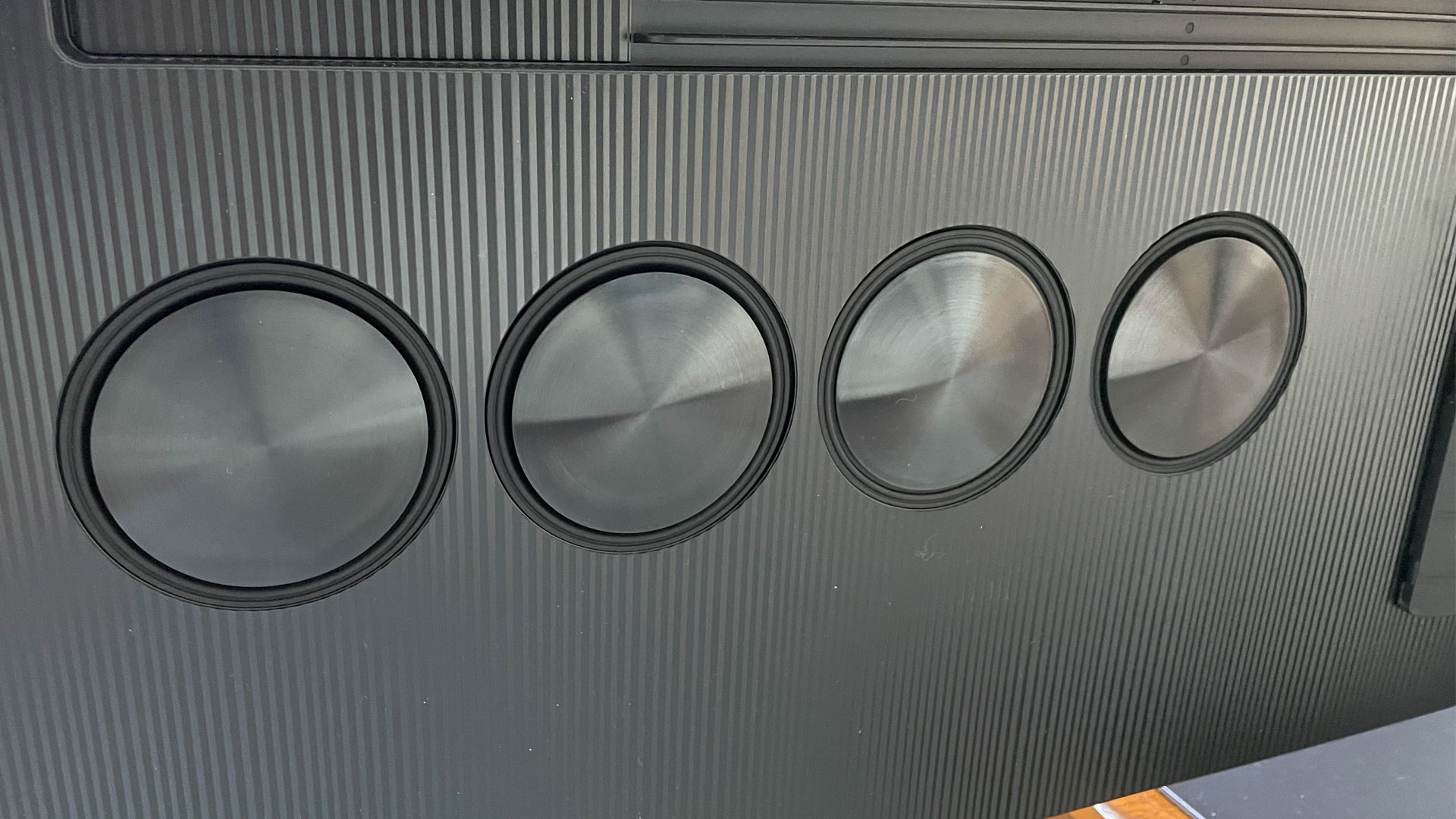
Samsung QN95C TV review: sound quality
- Impressive detail reproduction and placement
- Wide soundstage
- Clean if not particularly deep bass
Despite not featuring any really obvious changes to its sound design, the QN95C actually sounds quite a bit better than its predecessor – particularly when it comes to the scale and cohesiveness of its soundstage. There’s more width and height to the sound, creating a larger wall of sound for Samsung’s OTS system to work with. The result is that specific placement effects such as voices, car engine sounds, gun fire and so on are positioned even more accurately than we’ve heard with previous OTS implementations.
Details sound clean and well rounded too, and the sense of space in a good (especially Dolby Atmos) soundtrack is cohesive and engaging, especially with all the well-placed and cleanly delivered effects making the film or TV show’s world feel so busy.
The eight mid-range drivers spread across the QN95C’s rear deliver low frequency sounds more cleanly and responsively than last year’s QN95B did. I’d still have liked bass to have more depth and weight, but at least low frequencies don’t cause nearly as much distortion and muddiness as they did before.
My main complaint about the QN95C’s audio is that while its soundstage is wider and cleaner, it still doesn’t have any real forward impetus to it, leaving you feeling at times like you’re watching a world behind your TV, rather than you being placed at the heart of the action. Note that getting the best results from the QN95C requires you to turn on its Amplify audio option.
- Sound quality score: 4/5
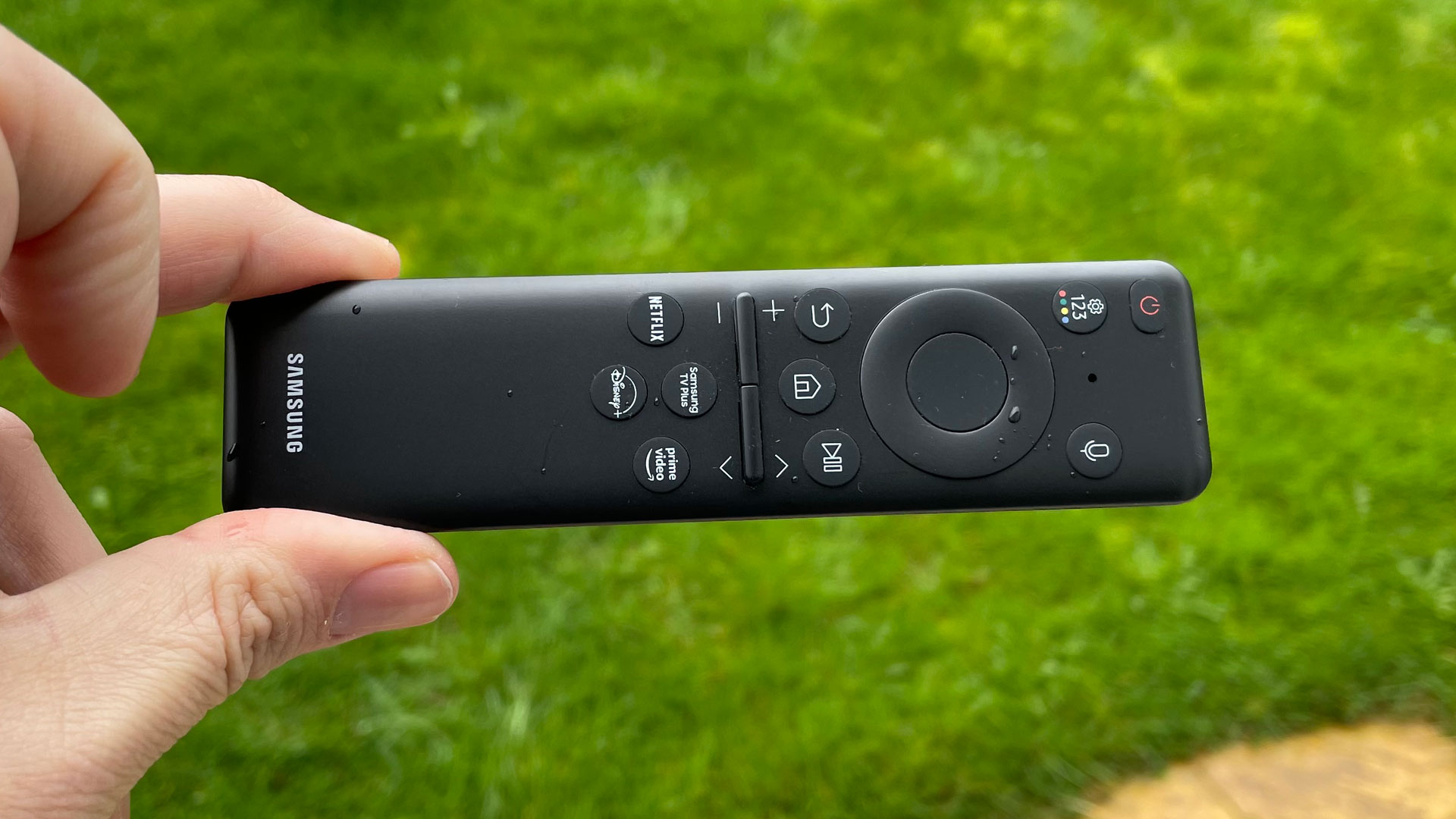
Samsung QN95C TV review: design
- Impressively slim and minimalist Infinity One sculpting
- Centrally placed desktop stand
- No One Connect box this year
Samsung has extended the ultra slim Infinity (now called Infinity One) design pioneered for its 8K TVs down to the QN95C, meaning it features an incredibly thin bezel around the screen, a remarkably slim rear for a TV that’s using a direct backlighting array, and sculpting for that rear that’s almost as flat as the screen.
Build quality is good enough to ensure the screen still feels reasonably robust despite the slenderness of its bodywork, and the centrally mounted stand means you can place the TV on a really quite narrow bit of furniture if you wish.
Unlike Samsung’s previous mini-LED flagship TVs, the QN95C doesn’t ship with an external ‘One Connect’ connections box. Instead all of its ports are fitted to the TV - so it’s nice to find the set providing some channels in the neck of its stand to help you keep cabling as tidy as possible.
The QN95C is supplied with two remote controls. The so-called ‘smart’ one you’ll probably use for most of the time is small, sleek and impressively low on buttons. It also, brilliantly, carries a solar panel on its back to save you from having to buy any batteries for it. Ever. It can even recharge using your router’s broadband signals if the solar panel is blocked.
The other remote is a relatively old-fashioned, button-heavy affair. But it’s still actually easier to find your way round than many such ‘traditional’ remotes are.
One last design feature of the QN95C is Ambient Mode. This allows you to play any of a wide selection of still images or video loops on the screen with minimal power consumption as an attractive alternative to just leaving a big black screen in your room in standby mode.
- Design score: 4.5/5
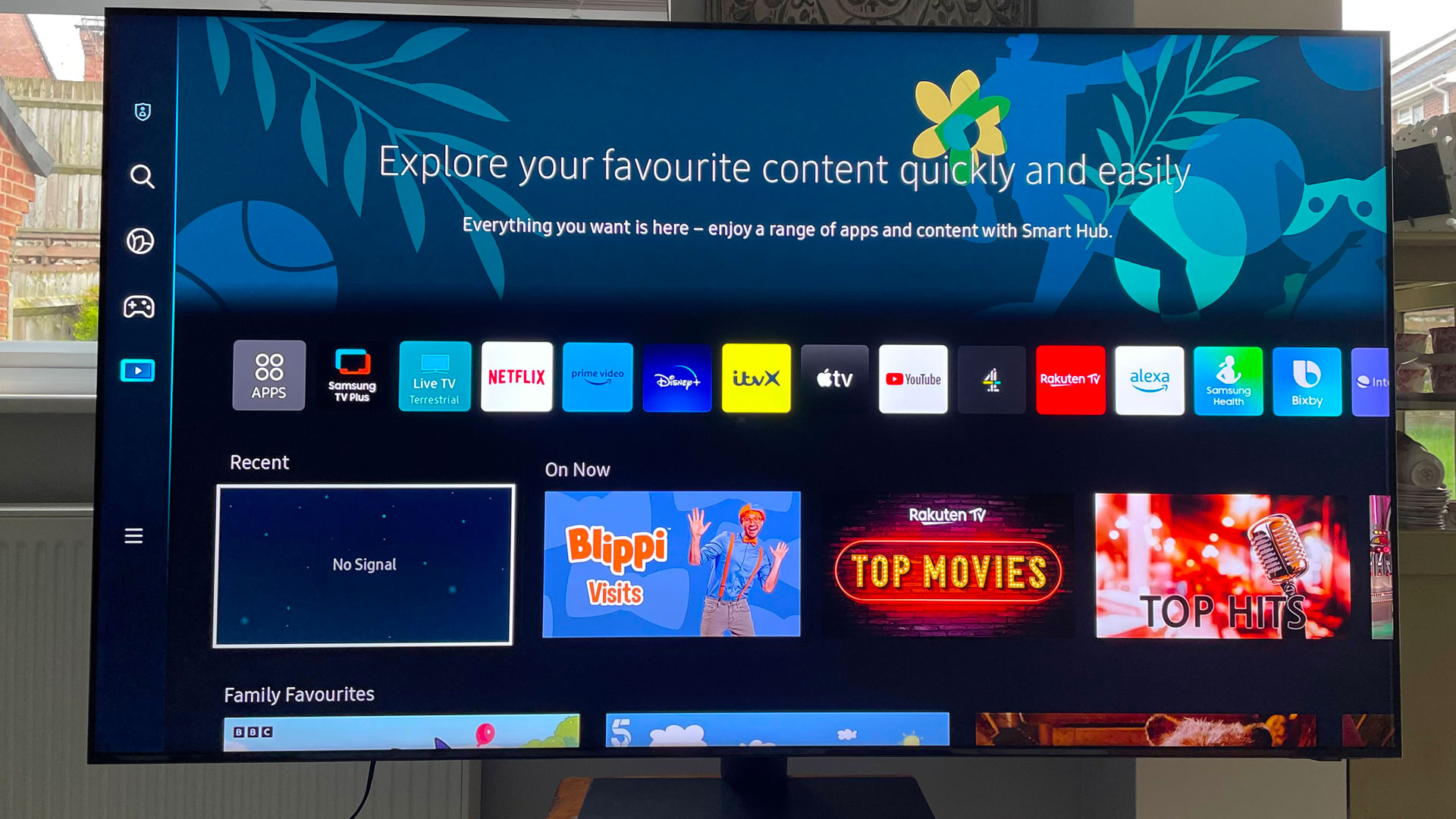
Samsung QN95C TV review: Smart TV and menus
- Second gen of Samsung’s new full-screen Tizen menus
- Comprehensive streaming app support
- Useful Gaming Hub
As with LG’s webOS when it went from an overlaid menu approach to a full screen system, Samsung’s switch to a full-screen look for its Tizen-based smart OS hasn’t been plain sailing. The first go at it last year really wasn’t helpful at all, feeling sluggish, hard to navigate and poorly focused when it came to helping you get to content you wanted to watch (unless you made good use of its voice recognition features, anyway).
Happily, Samsung has improved things for 2023. The home screen now features more sensible default content ‘shelves’ than its predecessor, and the options you get when you scroll down to further content shelves have been streamlined. Samsung’s Game Hub has also become an excellent one-stop shop in the menus for all your gaming needs - especially as connected gaming sources sitting alongside cloud gaming services on the Game Hub home screen.
The interface now runs more slickly too, and Samsung’s excellent voice command support still gives you a great shorthand way of avoiding the onscreen menus altogether once you’ve got used to the idea of talking to your TV.
I still think the implementation of the picture and sound adjustments into the smart menus feels clumsy, though, and I don’t like how much screen real estate is given over to advertising. I also wish Samsung would join almost every other UK TV in supporting the Freeview Play app (though it does support all of the UK’s main terrestrial broadcaster catch up services individually), and some AV fans may also rue the lack of Dolby Vision support with services such as Netflix, Disney Plus and Apple TV Plus. Though as we’ve seen, this doesn’t actually stop the QN95C from delivering superb HDR pictures from any HDR source.
- Smart TV & menus score: 3.5/5

Samsung QN95C TV review: gaming
- 4K/120Hz support (144Hz is actually possible)
- HDMI and AMD FreeSync Premium Pro VRR support
- 9.8ms 60Hz input lag
The QN95C is a fantastic gaming monitor. On the features side of things, all four of its HDMI ports support the full 48Gbps implementation of the HDMI 2.1 standard, complete with playback of 4K graphics at 120Hz refresh rates and variable refresh rates in both the ‘standard’ HDMI and AMD FreeSync Premium Pro versions. In fact the refresh rate can even extend to 144Hz.
The screen will also support ultra wide aspect ratio gaming with PCs that support that feature, and in Game mode input lag drops to just 9.8ms with 1080p/60 sources. Samsung has also provided the option to introduce mild motion smoothing to the picture with only a minor detriment to input lag if you’re playing, say, an RPG game that isn’t dependent on trigger speed reactions.
There are also virtual aim point and minimap zoom gaming aids this year, alongside the previous ‘cheat’ of being able to boost the brightness of exclusively the dark parts of the picture to make enemies hiding in dark corners easier to see.
Samsung supports the HGiG system where the console can be calibrated to your TV’s capabilities and then get the most appropriate HDR output levels from compatible game engines, and as with most TVs now, the QN95C can use HDMI 2.1’s Auto Low Latency Mode (ALLM) switching to automatically shift between its Game preset and video presets depending on the sort of content your console or PC is playing.
All of the QN95C’s gaming features, finally, can be accessed via a dedicated Game Bar menu accessed simply by holding down the Smart remote’s Play button.
All these features contribute to a consistently dazzling gaming performance that benefits hugely from the screen’s brightness, colour punch and sharpness. Perhaps even better, though, the improved contrast makes the QN95C much more comfortable with dark game settings than its predecessor, as well as its gaming pictures somehow managing to remain pretty much entirely free of backlight blooming even where a particularly bright white HUD element is presented against a nearly black backdrop.
The lack of support for Dolby Vision gaming from Xboxes and PCs may be an issue for some, but with the HDR10+ Gaming option on, at least, I really struggle to imagine many users not feeling ecstatically happy with how their games look on the QN95C.
- Gaming score: 5/5
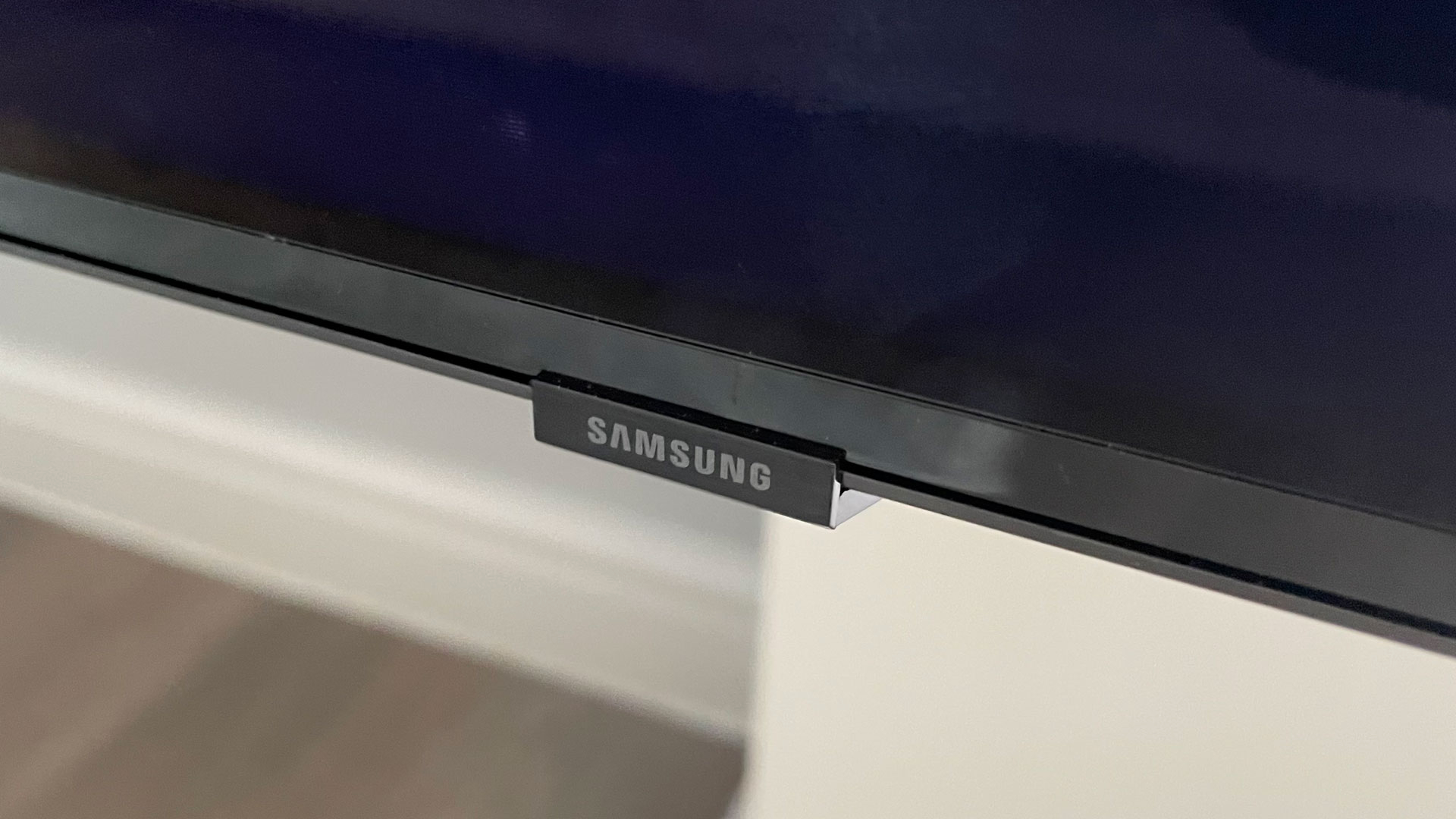
Samsung QN95C TV review: value
- Samsung’s most expensive 4K TV
- Costs more in the UK than QD-OLED
The £3,699 UK price for the 65QN95C is about as high we expect to see for a 65-inch TV from a mainstream brand in 2023. Pricing it above Samsung’s own S95C QD-OLED TVs is a bold move, too - especially as Samsung in the US has not followed the same path.
Being able to get the 65S95C for £100 less or a 65-inch LG G3 OLED for £200 less at the time of writing might turn a few potential 65QN95C buyers’ heads. As might the fact that Samsung’s step-down 65QN90C is £700 cheaper if you don’t mind losing a bunch of dimming zones, some brightness and the Infinity One design.
On the other hand, though, with its explosion in dimming zones the QE65QN95C offers a strong jump in performance from its similarly priced (at launch) flagship Mini LED predecessor, while its brightness - especially with full screen bright HDR content - still gives it huge appeal versus its OLED rivals for the sort of sun-drenched living rooms many people live in. Especially when the extra dimming zones means it also handles the dark, movie night stuff OLED is renowned for better than any LED TV before.
- Value score: 4/5
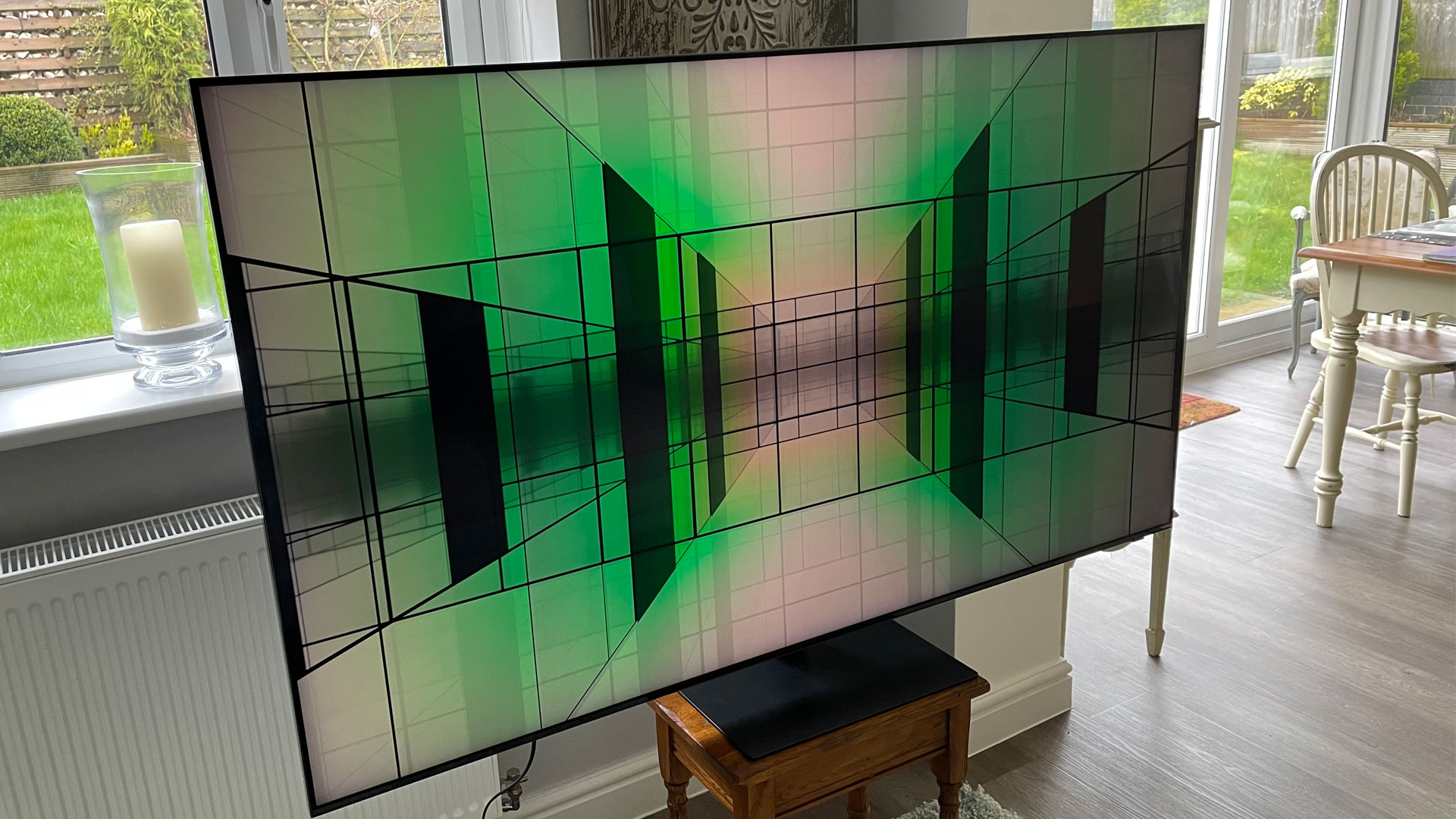
Should I buy the Samsung QN95C TV?
Even though OLED and QD-OLED TVs are both seeing much bigger enhancements for 2023, especially when it comes to brightness, than we’d usually expect to see over a single TV generation, the Samsung QN95C still maintains a more than substantial enough brightness advantage over even the best new OLEDs to make it an invaluable option for light room environments - or people who just love bright HDR.
The fact that it maintains its brightness advantage while also improving colour saturations, black levels and general levels of refinement and image depth all also help its case massively in this unprecedentedly competitive year for TV, too. Especially if you’re prepared to make a few visits to the QN95C’s set up menus to fix a few out-of-the-box foibles.
If your room isn’t typically particularly bright and you prefer a more consistent and arguably cinematic picture with peerless local contrast, the new LG G3 OLED and Samsung QD-OLED S95C TVs may be more up your street. Especially now that just as the QN95C has closed the gap on OLED in black level terms, these new premium OLEDs have closed the gap on mini-LED’s brightness advantage.
| Attributes | Notes | Rating |
|---|---|---|
| Features | Improvements to backlighting, picture processing, and sound, and also includes a new detachable camera | 5/5 |
| Picture quality | Double the dimming zones over its predecessor and better processing delivers strong improvements | 5/5 |
| Sound quality | Sounds much better than its predecessor and good by the standards of the TV world | 4/5 |
| Design | The ultra-slim Infinity One design together with the Ambient Mode both help it to fit nicely into almost any room | 4.5/5 |
| Smart TV and menus | The smart system isn’t very easy to follow, though the excellent voice recognition system helps a LOT | 3.5/5 |
| Gaming | Barnstorming gaming performance reinforced by reduced backlight blooming | 5/5 |
| Value | Very expensive, but its all-round performance will likely surpass any other mini-LED TV in 2023 | 4/5 |
Buy it if...
You feel the need for brightness
For all its big improvements this year, OLED technology still can’t get close to the brightness mini-LED technology can give you. Especially when it comes to full screen brightness.
You want a TV design that won’t destroy your living room
With its ultra-slim form factor and frame and engaging Ambient Mode, the QN95C can actually feel like an enhancement to your decor.
Don't buy it if…
Dolby Vision is high on your wish list
Samsung continues to believe its HDR processing is good enough to mean it doesn’t need to pay for a Dolby Vision HDR license.
OLED suits you more
OLED’s peerless local contrast capabilities have been taken to another level by the latest MLA and QD-OLED technologies, making them even better options for relatively dark room environments.
Also consider...
| Samsung S95C | Sony A95K | Samsung QN95B | |
|---|---|---|---|
| Price: | $3,299 | $2,799 | $1,999 |
| Screen type | OLED | OLED | QLED with mini-LED |
| Refresh rate | 120Hz | 120Hz | 120Hz |
| HDR support | HDR10+, HDR10, HLG | Dolby Vision, HDR10, HLG | HDR10+, HDR10, HLG |
| Smart TV | Tizen | Google TV | Tizen |
| HDMI ports: | 4 HDMI 2.1 | 4 HDMI 2.1 | 4 HDMI 2.1 |
| Built-in tuner | ATSC 3.0 | ATSC 3.0 | ATSC 3.0 |
Samsung 65S95C
Samsung’s second generation of Quantum Dot technology has yielded a huge upgrade over its debut in the form of the 65S95C. It’s much brighter but also much better controlled than its predecessor.
Sony XR-65A95K
Although this is a 2022 TV (Sony’s 2023 QD-OLED TVs aren’t expected for a few months yet), it still delivers a stunning combination of QD-OLED colour purity and accuracy-based refinement.
Samsung 65QN95B
At the time of writing, Samsung’s 2022 mini-LED flagship is still around, despite the launch of the newer model. And happily, the arrival of a successor means this older model is now discounted to £1,999. This set isn’t as good with black level, local contrast or colour as the QN95C, but at this price it’s still a great bright room option.
How I tested the Samsung QN95C TV

- Used test signals sourced from the Spears & Munsil Ultra HD HDR Benchmark 4K Blu-ray disc
- Was evaluated side-by-side with Samsung's 2022's S95B QD-OLED and a Philips OLED65907 OLED TV
- Brightness measurements were taken using an X-Rite i1 Display Pro light meter
The 65QN95C was tested in both dark test room and bright living room environments, using a mixture of familiar ‘real life’ footage and test signals sourced from the excellent Spears & Munsil Ultra HD HDR Benchmark 4K Blu-ray disc. I also managed to test the 65S95C while it was running right alongside both its 65S95B predecessor and a Philips OLED65907 OLED TV using an HDFury Integral HDMI 4K splitter.
Titles that proved particularly useful for this test given the importance of testing its new potential contrast performance, along with how much of a brightness advantage LED technology might hold over the latest OLED TVs, were the 4K Blu-ray of Pan (with its 4000 nits master) and the first of Andy Muschietti’s It films - specifically the ultra dark sequences where Georgie visits his home’s cellar in the film’s opening scenes. I also used the very dark sequence where the bully looks for Ben in Derry’s sewers before stumbling across Pennywise.
Gaming abilities were tested predominantly with a mixture of Call Of Duty Modern Warfare 2, especially in 120Hz mode, Assassin’s Creed: Valhalla, and Dirt 5. Brightness measurements were taken using an X-Rite i1 Display Pro light meter, while input lag was tested using a Leo Bodnar HDMI Video Signal Lag tester.
- First reviewed: April 29, 2023

John has been writing about home entertainment technology for more than two decades - an especially impressive feat considering he still claims to only be 35 years old (yeah, right). In that time he’s reviewed hundreds if not thousands of TVs, projectors and speakers, and spent frankly far too long sitting by himself in a dark room.
